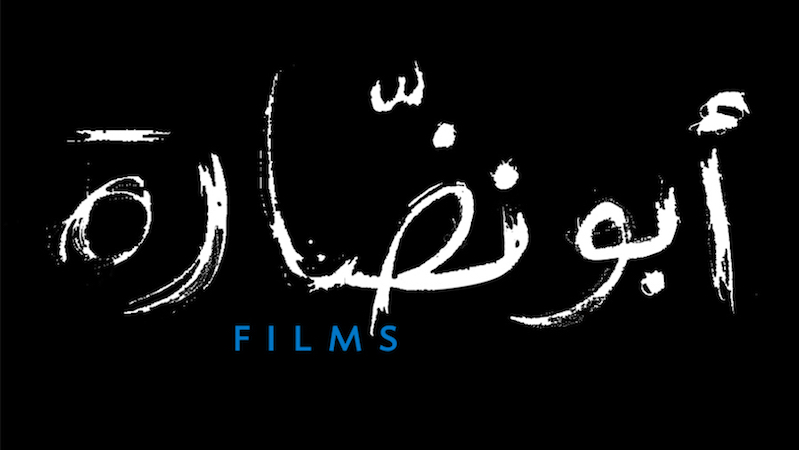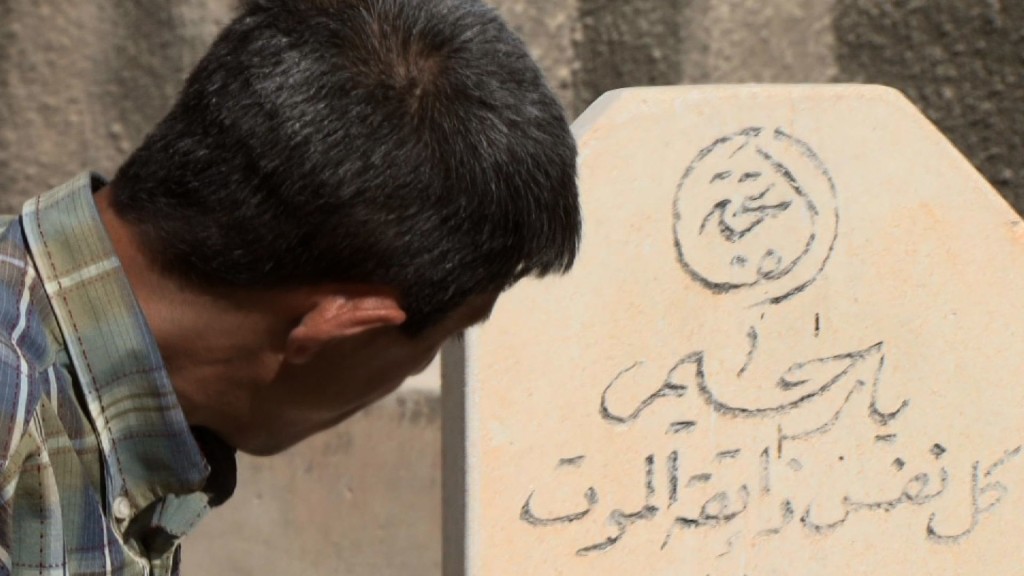When Syrians took to the streets to denounce the rule of President Bashar al Assad in 2011, protesters in the revolutionary city of Homs summarized their goals in a chant: “It’s a Syrian, Syrian Revolution! For freedom and dignity!”
The inability of Syrians to achieve their demands has been well documented. Despite the unifying rhetoric, conflict has divided Syria and fostered sectarianism. Assad remains in power, and the rebels holding Syrian territory include illiberal groups like the Islamic State.
The anonymous film collective Abounaddara fights for another unachieved goal: Syrians’ dignity. The collective’s name means “the man with glasses,” a reference to documentary cinema, which it uses to “defend Syrians’ right to an image that is dignified and independent of political and media agendas.” The collective works to provide an alternative image of Syrian society, different from the prevailing narrative found in government propaganda and mainstream media. Since 2011, the anonymous filmmakers have released a short — 1- to 12-minute — film every week.
The collective has described its work as “bullet films” and its members as “snipers” who sabotage Bashar al Assad’s propaganda through seemingly innocuous films. Many feature regular Syrians telling a story. In Confessions of a Woman—Part Two, a woman describes how the conflict has increased her awareness of sectarianism. Other films such as Who is the Military Fighting? use more artistry, showing a toy soldier crawling through peaceful urban streets.
Abounaddara criticizes the “pornographic” portrayal of dead and suffering Syrians, especially in Western media, and calls for the recognition of “the right of the image” as a human right – a right that would protect Syrians and others from the use of their images in photographs and videos without their consent.
Abounaddara represents a grim yet impressive example of the saying, “necessity is the mother of invention.” Despite working with limited resources in a dangerous environment, the collective’s work won the Short Film Grand Jury Prize at the 2014 Sundance Film Festival, and is a finalist for the 2014 Human Rights Tulip Prize, awarded by the Dutch government.
All but two Abounaddara members are anonymous. The collective revealed that citizen journalist Osama al-Habaly is a member after his arrest in August of 2012. Charif Kiwan is a founding member of the collective and its spokesperson. The group collectively answered the following questions over email. It has been lightly edited and translated from the French by Tadzio Koelb.
– AM
1. When did the first members of Abounadarra found the collective? Was its founding spurred by a specific event?
It was out of desperation that we launched our collective in 2010. For years each of us had been making films of our own without ever getting any interest from producers or distributors. We absolutely had to change the way our society was represented — a representation monopolized by a tyrannical government and a blind culture industry. And we wanted to believe it was still possible to do that.
2. What was your aim or goal when you founded Abounadarra? Did you always intend to make films, or did you come to the conclusion that film was the best tool to achieve the collective’s goals?
The aim was to ensure that our society could control its own image, without intervention by the state and the market. But the only way to challenge the state monopoly on representation without risking prison was to make seemingly innocuous movies and distribute them over the Internet. We did that by broadcasting a series of portraits of ordinary people in 2010. We were testing the censor, who could have penalized us for not having submitted our films. But our films must have seemed politically correct to him. And he must have thought that our anonymity was just an artistic flourish, as we weren’t directly dealing with anything political. That said, we already had other projects in mind: films in different formats, texts, a slyly subversive blog about a mythical animal (the Syrian brown bear), and so on.
3. The situation in Syria has changed dramatically since the founding of Abounaddara. Have your goals and approach changed as well?
Our goal hasn’t changed since 2010 insofar as we are still working to break the monopoly held by the Assad regime and the culture industry over the way our society is represented. But our methods have evolved according to our constraints. Since April 2011, we’ve been trying to achieve this goal by making a short film every Friday, using every artistic genre. So, depending on the subject, we might use the vocabulary of documentary cinema, of photography, of the video clip, of reportage, of agitprop, etc. We sometimes also publish critiques. And recently, we launched a campaign for “the right to the image,” which we will continue in New York with the help of our friends at The New School.
4. Although you produce documentary films, you say you are not just “trying to capture the tragedy…as it unfolds.” Your films differ from the work of activists and citizen journalists who, as you say, use their footage of bombings and fighting and massacres to indict the other side — and ask viewers of their videos to act as judges. Why has Abounaddara chosen “the aesthetics of cinema” to achieve the collective’s goals? Do you think your approach is more effective than the citizen journalist approach? Or how do your films complement the work of activists and citizen journalists?
We didn’t choose anything at all. We just wanted to make movies because we love this art, and it allows you to reconstruct reality with a certain economy of means. But we wanted a cinema suited to the needs of our society, not the laws of the Syrian state and the culture industry. We wanted to render visible our society independently of the stories told by powers that do not recognize our right to a dignified image. And cinema allowed this. It let us leave behind the geopolitical or religious prism through which one usually views Syrians (in our films, Syrians are not defined by their associations with a particular region or religion). It allowed us to escape mainstream media’s pornography of the real (in our films, the news is always seen in perspective, or at least approached with detachment or derision).
As for citizen journalists, we respect their work all the more because we regularly work with them or use the valuable images they produce (see especially Apocalypse Here; The Fly). One of our comrades, Osama al-Habaly, is a citizen journalist. He made wonderful movies on behalf of our group, including Zeina. And he delivered a remarkable analysis of the functioning of the media in the film Media Kill. Osama was arrested by the Syrian security services on August 18, 2012; since then we have had no news.
Meanwhile, our other citizen-journalist friends have lost all hope of constructing an alternative to the media industry. Some have no choice but to act as subcontractors for the established media, with the effect of lending them a certain moral authority.
5. The collective has described its films as bullet films, and you have described Abounaddara’s members as snipers, ambushing the Assad regime with films. Yet your devotion to giving voice to Syrians includes sharing the perspective of people who support the regime. Can you explain how you ambush the Assad government without editorializing in your films?
We are indeed sniper filmmakers creating “bullet films.” But we are not targeting Bashar al-Assad alone. So, although we are firmly committed to the revolution, we have also made films extremely critical of the revolution, e.g.: Betraying the Revolution; The Unknown Solder – Part 3; The Islamic State for Dummies). So much so that the main pro-regime newspaper in Lebanon praised our work in an article emphasizing our independence. We are also targeting the culture industry and all those who, here or elsewhere, violate Syrians’ right to a dignified image (e.g.: Kill Them; Two Minutes for Syria).
6. I understand that many volunteers contribute footage to the collective, and members of Abounaddara collaborate on the editing process over the Internet. Can you explain how the collective collaborates to produce a finished film?
We prefer not to disclose our working methods, because our collective is made up of anonymous artists who work in the underground. The world needn’t know how we work. It’s nobody’s affair, unless it’s the big brother who is watching you. For us, secrecy is security, of course. But it also is a means of resistance against the culture industry, which tends to cut artists off from their societies by locking them in a sort of golden ego. In other words, we want our films to surprise the world and escape any individual control so as to maximize their impact. We also want our society to accept these films as collective works and not as products of a specific artist.
7. You publish a video on Facebook, Vimeo, and other websites every Friday. How else do you get the word out about your films? Is the decision to publish your films on Friday — which is traditionally the largest day of protests and demonstrations in the Arab World — symbolic, strategic, or both?
We are independent artists who cobble together movies in secret by whatever means we can. We work entirely on a voluntary basis within the collaborative economy. In other words, we have no way to promote our films.
Since April 2011, we have broadcast a movie every Friday via Vimeo. Right away, we share the movies on our Facebook and Twitter pages counting on our audience to promote them. As for Friday, it was imposed on us since our society has decided to demonstrate against the state every Friday. We decided to support that by making movies without waiting to find a producer, distributor, or festival.
8. Abounaddara avoids using images of dead or injured Syrians, and you have criticized the saturation of violent images from Syria in the media. Yet several films, such as Apocalypse Here and The Eagles of Syria, do show dead or injured Syrians. Could you explain why you avoid images of violence and why you decide to include footage of bodies or injured Syrians when you do?
Indeed, we avoid showing the battered or defiled bodies of Syrians. This is a principled position that our collective adopted in the first days of the revolution while denouncing the media’s tendency to favor a “pornographic” approach. Our position is based on arguments that are aesthetic (death in close-up offers no more information about a crime than pornography does about love), political (Syrians are not victims of a natural disaster, but men and women who are fighting for an ideal of freedom and dignity), legal (individuals’ rights to their images must be respected in all circumstances), and ethical (pity is dangerous, especially when it is preached by a media with a vested interest in disseminating sensationalist images).
The principle is that people’s dignity should be preserved within their images. Therefore, when we show the dead or injured, which is relatively rare, we respect the rules in force in the American and European media, which, remember, did not show images of the victims of the September 11, 2001, attacks. Every time we want to represent the massacre of our compatriots, we think of Samuel Fuller, who filmed a concentration camp without giving in to the urge to film the corpses, and Jacques Rivettes, who has denounced the trivialization of evil on the screen (see his essay “On Abjection“).
9. You have said that you want your films to counter not just the propaganda of ISIS and the Assad government, but also the false narrative of the Syrian conflict presented by Western media. How do you believe Western media misrepresents Syria? Why do you think it does so?
You are mistaken. It’s Bashar al-Assad who criticizes the Western media, not us. And he is not alone. Many other demagogues have done the same since al-Jazeera transformed criticism of Western media into a marketing campaign. Even the Western media criticizes the Western media! Thus we have seen a number of outlets invoke this criticism to justify the dissemination of YouTube videos made by Syrian activists. Except that was a marketing ploy, one, which claimed, “Here is the true reality, as seen by the natives themselves”. In truth, this is an attempt to legitimate the dissemination of images that are sensationalist, obscene, or contrary to human dignity — but profitable — without risking legal action over their violations of the right to the image (the poor in Syria and elsewhere do not have the means to hire lawyers to defend their right to the image).
What we find interesting is a critique of media representation in general based on intimate knowledge of the industry, an approach to which we have devoted several films and texts (see Media Kill; or “Cellphone War Reporting Dumbs Down the Truth” in Newsweek). And we are sorry that our criticism was not understood by specialists worldwide. This is because your media industry has gone blind. Not only did it fail accurately to represent the struggle between Syrian society and the state, but it acted as a global outlet for both Bashar al-Assad’s and ISIS’s communication strategies. It thus trivialized evil and turned the weapons of democracy against democracy itself.
10. The collective’s filmmakers are self-taught, and you have described your films as “emergency cinema,” because like in emergency medicine, you are using the limited tools at your disposable to deal with a crisis. Yet Abounaddara has received media attention and won the Short Film Grand Jury Prize at the 2014 Sundance Film Festival. Have you used your public recognition as a tool to spread your films? Or to attract resources or raise funding to support your work? Have professional filmmakers expressed interest in working with you?
The emergency cinema we practice hasn’t received recognition, at least insofar as we have received no funding, although our originality seems widely accepted. Our award-winning films are shown at Sundance and at the Venice Biennale, but nobody wants to fund our projects. Why? Hopefully those in the culture industry will have time to think about this question. Because as of today, we are poorer than when we started five years ago. And there is concern that we may become unable to produce films before recognition brings any results.
11. What does success look like for the Abounaddara collective?
Success would be if our bullets find their targets, and nobody — either Bashar al-Assad or the culture industry — dares to monopolize the representation of our society.
•
 Alex Mayyasi is a San Francisco–based writer. He is the co-author of The Spark, a forthcoming book about the Egyptian Revolution, which he began writing in Cairo in 2011–2012. He is also a former writer at Priceonomics, where he co-authored two books. You can follow him on Twitter @amayyasi.
Alex Mayyasi is a San Francisco–based writer. He is the co-author of The Spark, a forthcoming book about the Egyptian Revolution, which he began writing in Cairo in 2011–2012. He is also a former writer at Priceonomics, where he co-authored two books. You can follow him on Twitter @amayyasi.



